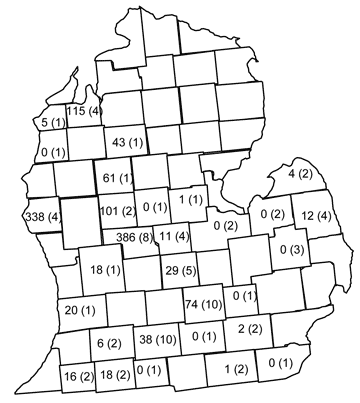Update: Western bean cutworm
Editor’s note: This article is from the archives of the MSU Crop Advisory Team Alerts. Check the label of any pesticide referenced to ensure your use is included.
Western bean cutworm flight is petering out across the state. Figure 1 shows the total moth catch per county as of August 1, as well as the number of traps per county in parenthesis (n). The timing and number of moths caught in western Michigan confirm we now have a resident, overwintering population of western bean cutworm. The traps also confirm the movement across the entire state to the Canadian border. Furthermore, egg-laying was confirmed in fields in the western part of the state in July. Many fields in the northwest were over threshold for egg masses (30 percent infestation confirmed by me in Oceana, and similar levels reported in Benzie, Grand Traverse, Leelanau, Missaukee and other northwest counties) and thousands of acres have been sprayed in that area. Eggs were found in southern Michigan as well, by Bruce MacKellar (St. Joseph MSUE), but were not over threshold. I have not yet had reports of eggs or larvae in dry beans, but I have found that scouting beans to find caterpillars is difficult, even on plants that I infested.
Scouting for eggs and larvae needed to begin when moths were detected, concentrating particularly on the weeks of peak catch. This was the last two weeks of July in most areas. Moths prefer to lay eggs in fields close to tasselling; this was very evident in the fields I visited in Oceana County. Differences in growth stage (thus attractiveness of fields for egg laying) explains some of the wide variability in the number of egg masses from field to field. Thus scouting was critical to determining which fields were infested.
By this time, eggs have hatched. Insecticide applications must be timed close to egg hatch and when small larvae are exposed on the tassel and leaf surface. We are past this window at most locations. The threshold for treatment is five percent of plants with egg masses or small larvae. Many bulletins and the MSU Insect Guide E-1582 give a threshold of eight percent. However, in discussions this winter with entomologist Tom Hunt from the University of Nebraska, I reduced the threshold this summer to five percent (five of 100 plants with eggs or larvae). More critical than which insecticide to spray was proper timing to kill exposed caterpillars, and we are again likely past the spray window, even if a field is infested. For those of you who planted a Bt hybrid, Herculex corn for European corn borer does kill western bean cutworm, although the control is not 100 percent control, and the refuge is still susceptible. Yieldgard-type corn does not kill western bean cutworm. Expect discussion of western bean cutworm at the 2008 - 2009 winter meetings, including presentations of whatever plot-data we can generate in the state.



 Print
Print Email
Email


